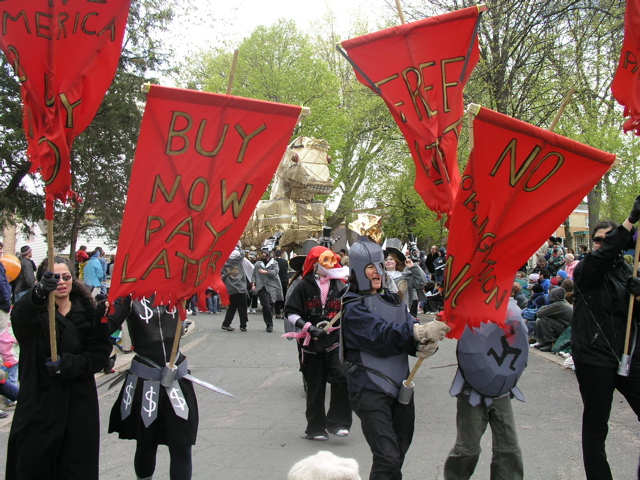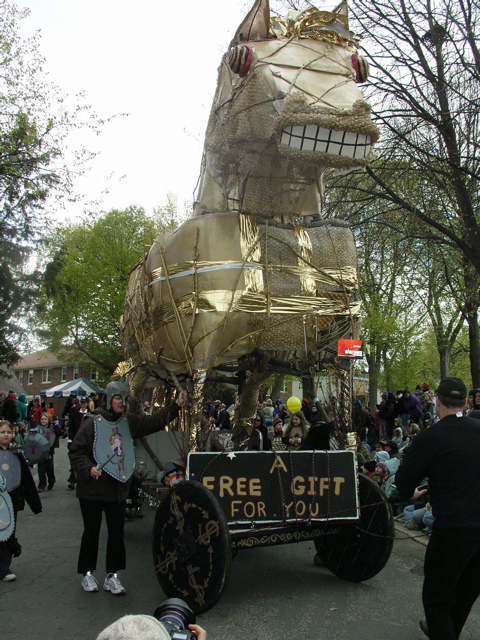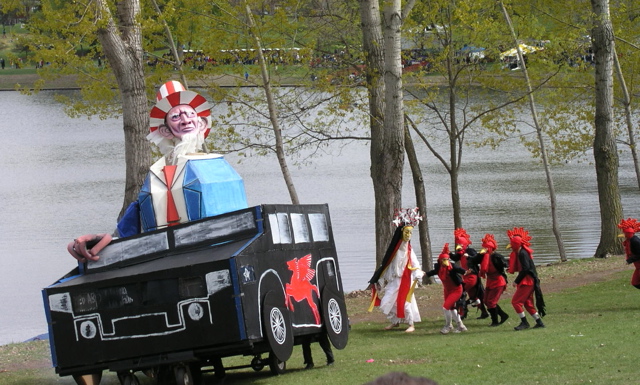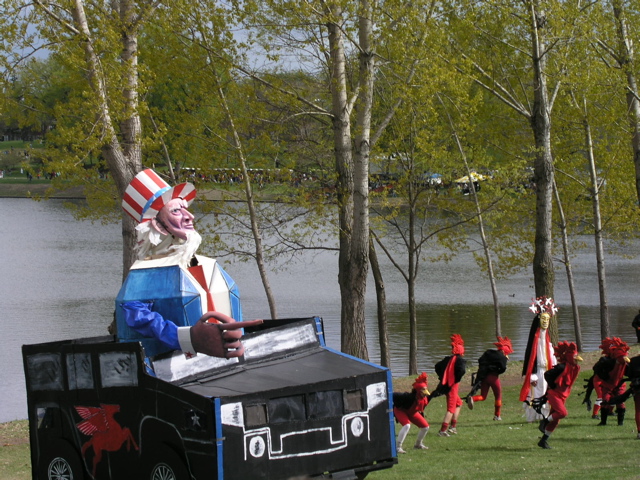The Arrival of the Sun
Coinciding with Heart of the Beast Lake Street Excavations (through July 16), Suz Szucs thinks here about Heart's May Day celebration and puppetry's role in public politics.





Running July 6-16, “Lake Street Excavations” will move along Lake Street –literally – as audiences tour the area to view site-specific installations and performances. All shows begin at In the Heart of theBeast Puppet and Mask Theatre, 1500 E. Lake Street, Minneapolis.
May Day
With slow spontaneity the crowd rose to its feet and shouted, in desperation, “Sun! Sun! Sun!” The four accompanying boats fought the current, but the raft carrying the sun, with a canoe on either side, was fighting against the wind. The large sculpture acted like a sail and blew the vessel back towards the island of its origin. The crew struggled to turn it right.
“Sun! Sun! Sun!” roared the crowd. No question about it, we all needed that sun to make it. We all needed to believe that the Tree of Life would raise and spin and bring us hope not only to counter the chilly, windy Twin Cities day (flurries tumbling out of the sky like God’s snow globe), but the long, cold winter of our impoverishment.
Since its earliest inception, puppetry has held the hand of politics and the annual May Day fest, orchestrated by Heart of the Beast, is no exception. This year’s parade and pageant presented a theme of mourning, for those who have died in the Iraq War. Dozens of volunteers marched with black banners upon which the names of the dead were painted in white. A humongous Uncle Sam in a Humvee puppet taunted the Tree of Life, but was eventually subdued by her and her cadre of trusty roosters. Then the mourners with their scroll of death marched down the hill onto the pageant floor, spreading the material like shrouds on the spring grass. Up from the lake rose primordial creatures, mouths agape with inexhaustible grief. They collected and carried the shrouds away as the names of the dead – military and civilian – were read out simultaneously by three speakers.
Uncle Sam himself was dismantled and decomposed by the virtuosity of the Heart of the Beast players, who removed the carcass and magically replaced it with the template of a renewed ecosystem. To follow would be the ritual of the Sun.
Puppetry
What makes Heart of the Beast work and has fueled the success of puppetry for millennia is the combination of magic and complicity: the magician gives a performance but it is successful only when the audience believes. Together they create a spectacle that is removed from the “real” of human presence, but is so uncanny in its lifelikeness that it can often speak truth more clearly than an actor on a stage. Freud described this phenomenon in his essay “The Uncanny.” We imbue a mechanical face with life, listen to it, sometimes we worship it. Somehow, it is easier for us to hear its message than the same words delivered by our neighbor. And by using this mediator we can get away with stuff – rebel, trespass, ridicule – that in person we would not be so easily able to negotiate.
Punch is an early Western example of political puppetry in action. In response to political oppression in England that outlawed theatrical productions, outdoor puppet theatres sprang up and Punch, the comic irreverent everyman, became a popular symbol of dissent. Puppetry has been running under the radar ever since, using satire and masking to critique society. Apparently it is still feared by the establishment, as demonstrated by the raiding of puppet studios and confiscation of artworks before major protests of the war and last year’s Presidential election.
While writing this column I learned from The Week that Ohio law prohibits the wearing of masks except by, “children, actors in plays, and workers who need facial protection.” (The Week, June 10, 2005, v5, issue 211, p 8)) Officials claim that this prohibition is to prevent the use of masks by criminals and terrorists, but what comes next? Will we restrict plastic surgery because it may change our appearance? Will we allow the government to see our library reading lists to check on what thoughts we might be having? Oh, I forgot, that’s already happened. It’s pretty dangerous, this game we are playing with civil rights. Masking is a way for us to anonymously speak out against authority. The Boston Tea Party Activists knew that, which is why they all dressed as Native Americans.
It is interesting to note that the restrictions on theatre in England coincided with those imposed on celebrating May Day, or the festival of Beltane, to use its common Celtic name. Cromwell’s Puritan government outlawed what they considered to be politically dangerous theatre in 1642; in 1644 that same government made celebrating Beltane illegal.
The history of May Day as a Pagan celebration can be traced back to Ancient Greece, with the month of May being named for the Goddess Maia. It was a festival holiday to celebrate the return of the Sun; the fertility rites practiced in conjunction became a great threat to the Christian church and its attempts to control property and social pacts through the establishment of monogamous marriage contracts. Interestingly, May Day is the one major Pagan festival that did not get translated into a major church holiday (Easter, All Saints Day, Christmas).
From Beltane to May Day
It’s not surprising, then, that Beltane, after suffering its own oppression, should be reborn as the International Workers Holiday. First celebrated in 1886 as a demonstration to demand better working conditions, that protest ended in the Haymarket massacre in Chicago. Despite the attempts of the American government to create a “safer” holiday for workers – Labor Day – May Day has continued to be celebrated by unionists throughout the world. These are the workers directly responsible for the 8 hour work day, the 6 1/2, then 6, then 5 day work week, the abolition of child labor (in this country at least), and the right of workers to safe working conditions (there was no OSHA in the 1880s).
The Heart of the Beast annual May Day fest blends these two histories, creating a celebration of the wonderment of the natural world with the richness of our protest heritage. The parade showcases not just puppetry as worship, but as protest – using fantastic creations to comment on the state of our culture. Christians, Buddhists and Pagans marched, if not side by side, then with agreement on many issues concerning social and environmental justice, just as trade unionists and environmentalists had come together at the World Trade conference in Seattle to protest unbridled globalism.
The Sun Arrives
We chanted, whistled and panted for what seemed like an eternity, and the Sun did, indeed, make it to shore. Doing so brought up the Tree of Life and simultaneously the clouds moved aside and the actual sun shone on a wildly appreciative crowd. It seemed as though we were being given another opportunity to start fresh, to rectify the hate and horror in this world. It was a reminder that wherever we go, whatever we do, we can always start anew. It’s been a hard year for a lot of folks. As I write this, I look down and take a sip from my cup of tea… the label on the bag has a little quip, a note to me… it says, “We can learn from a tree how to exist in ecstasy.” Yeah, that sounds about right, and thanks to the annual May Day festival I am ready to take on another year and take heart from fellow participants that perseverance will, indeed, bring the Sun across the shore.